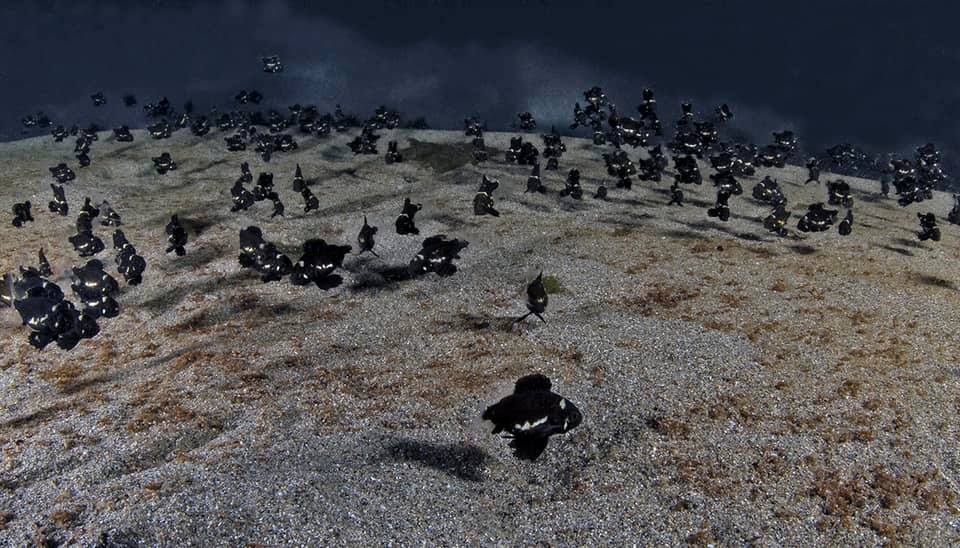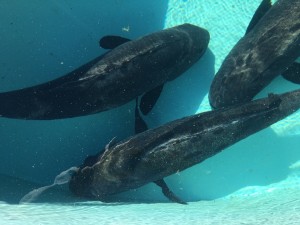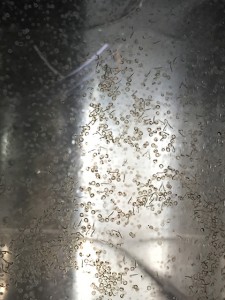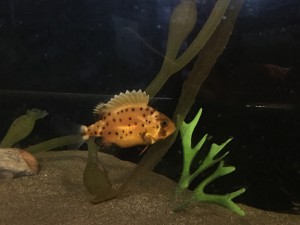Effort to Capture Mating Sound Leads to Unexpected Birth of Hundreds of Critically Endangered Giant Sea Bass

Some of the hundreds of baby sea bass juveniles born unexpectedly while CSUN marine biologist Larry Allen was trying to capture the source the critically endangered fish make when courting. Photo by Michael Couffer.
What started out as an attempt to record the sound the critically endangered giant sea bass makes when it spawns has left California State University, Northridge marine biologist Larry Allen with about 700 sea bass “babies” that he hopes to release into the ocean soon.
“This isn’t what I intended or thought would happen when I started this project,” said Allen, who is waiting for word from California Fish and Wildlife for when he can release “my babies” into the ocean. “Past efforts to breed giant sea bass in captivity haven’t been particularly successful — maybe a dozen or so larvae at a time. Certainly not 500 to 700.”
Allen has spent more than three decades studying the giant sea bass (Stereolepis gigas) and conservation efforts to save the perch-like fish. Giant sea bass, which can reach up to 700 pounds and more than 8 feet long, can be found mostly off the coast of California. Almost hunted to extinction, they are listed internationally as critically endangered and are protected in California.
The fish’s numbers have increased over the years, “but we still have a way to go,” Allen said.

The “teenaged” giant sea bass involved in marine biologist Larry Allen’s effort to capture the sound the critically endangered fish make when they are courting. Photo courtesy of Larry Allen.
To help the giant sea bass’s chance for survival, Allen and a team of students led by CSUN marine biology graduate student Emily Ladin set out to get a recording of the sound the fish make when they are courting, to help fisheries biologists identify when and where the fish are spawning so that they can protect those areas.
“We wanted to make sure we had a sound that was clearly identified as belonging to this particular species of fish,” Allen said.
This summer, Allen, Ladin and their team set up one male and two female “teenage” giant sea bass in a tank at the Southern California Marine Institute. The tank was equipped with an underwater microphone in hopes of capturing a clear recording of the sound the male makes during courtship.
“It’s made by the fish squeezing its ribs with special muscles; the ribs hit the air bladder and it sounds like a snare drum,” Allen said.
Every couple of days, the team tried different microphones and placements of the recording devices in an effort to capture the best recording possible.

Some of the giant sea bass eggs and larvae marine biology graduate student Emily Ladin discovered the morning after recording the sound the fish make while courting. Photo courtesy of Emily Ladin.
One morning late in June, while Allen was away in Europe, Ladin returned to the tank to check on the recording set for the night before, and she discovered thousands of giant sea bass eggs — each about 1 ½ millimeters, or little more than a 10th of a centimeter, in length — floating throughout the tank.
“They were everywhere,” Ladin said, adding that no one on the team had expected their subjects to actually spawn.
Ladin frantically called Allen to see what they could do to save the eggs. A few phone calls, texts and emails later, the Cabrillo Marine Aquarium and the Aquarium of the Pacific agreed to serve as nurseries for the critically endangered fish.
Within hours, Ladin was driving across the Vincent Thomas Bridge with jars, buckets and ice chests filled with water and thousands of giant sea bass eggs, some of which were already hatching. Those containers not held in place in by seat belts, she carried in her lap.
“I kept trying to figure out how I was going to explain to a police officer, if I got stopped, that I was taking my babies to the aquarium so that they had a chance to live,” Ladin said.
In all, Allen estimated that more than 100,000 giant sea bass eggs were spawned that night, adding “we also got a great recording.” (To hear the recording, click on the audio below.)
Both aquariums dedicated animal care teams to ensure as many of the eggs as possible hatched, and to ensure that, once hatched, as many as possible of the juvenile giant sea bass survived. Allen said about 700 juvenile giant sea bass are now waiting to be released into the Pacific Ocean.
“We’re just waiting to hear from California Fish and Wildlife,” he said. “We’re hoping it will be sometime this month because our babies are getting to be too big for the tanks they are in right now.

One of Emily Ladin’s giant sea bass babies in its early stages of development. Juvenile giant sea bass start out as orange before they mature to black. Photo courtesy of Emily Lapin.
“The good thing is, we know who their parents are,” Allen said, adding that the parents were released back into the ocean soon after the eggs were spawned and the recording captured. “We have their DNA and they are tagged. The babies also are being genotyped so we will be able to keep track of them once they are released.”
Ladin said the tags allow her and Allen to monitor the fish as they grow and make their homes in the Pacific.
Ladin said giant sea bass are “rather cuddly” for fish.
“They like to rub up against you and let you rub their scales,” she said, adding she had a warning to any fisherman who may stumble upon the fish once they are released.
“My babies are tagged,” she said, “and I’m going to know if you do anything to them.”

 experience
experience